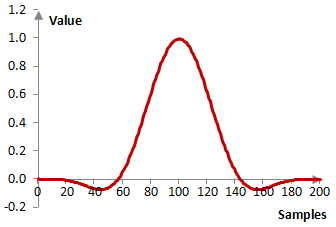The flat top window coefficients are given by the following formula
$$a(k)= 0.21557895-0.41663158 \, \cos(\frac{2 \pi k}{N-1})+0.277263158 \, \cos(\frac{4 \pi k}{N-1})$$ $$- 0.083578947 \, \cos(\frac{6 \pi k}{N-1}) + 0.006947368 \, \cos(\frac{8 \pi k}{N-1})$$
where N is the length of the filter and k = 0, 1, …, N – 1.
An example flat top window
Consider a finite impulse response (FIR) low pass filter of length N = 201. The following is the flat top window.

Given a sampling frequency of 2000 Hz and a filter cutoff frequency of 40 Hz, the impulse response of the filter with a rectangular window (with no window) and with the flat top window is as follows.

The magnitude response of the same filter is shown on the graph below.

Measures for the flat top window
The following graph shows the discrete Fourier transform of the flat top window against the transform of the rectangular window.

The following are selected measures for the flat top window.
| Coherent gain | 0.22 |
| Equivalent noise bandwidth | 3.78 |
| Processing gain | -5.77 dB |
| Scalloping loss | -0.01 dB |
| Worst case processing loss | -5.78 dB |
| Highest sidelobe level | -93.6 dB |
| Sidelobe falloff | -12.1 dB / octave, -40.1 dB / decade |
| Main lobe is -3 dB | 3.72 bins |
| Main lobe is -6 dB | 4.00 bins |
| Overlap correlation at 50% overlap | -0.015 |
| Amplitude flatness at 50% overlap | -0.110 |
| Overlap correlation at 75% overlap | 0.044 |
| Amplitude flatness at 75% overlap | 0.938 |
See also:
Window
Add new comment